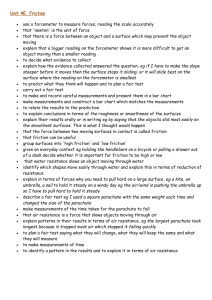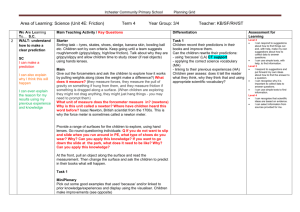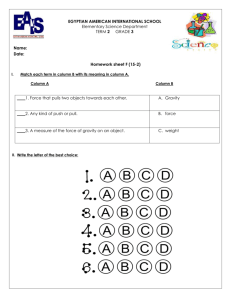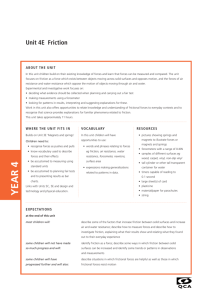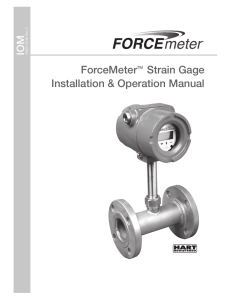- Smart Science
advertisement
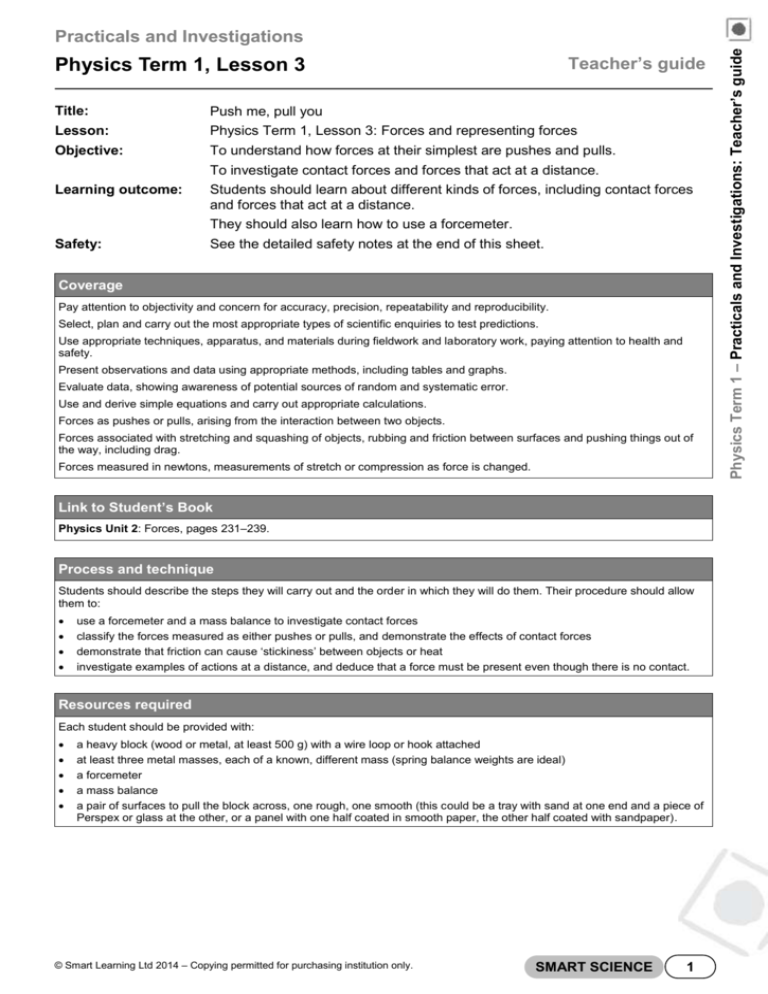
Teacher’s guide Physics Term 1, Lesson 3 Title: Push me, pull you Lesson: Physics Term 1, Lesson 3: Forces and representing forces Objective: To understand how forces at their simplest are pushes and pulls. To investigate contact forces and forces that act at a distance. Learning outcome: Students should learn about different kinds of forces, including contact forces and forces that act at a distance. They should also learn how to use a forcemeter. Safety: See the detailed safety notes at the end of this sheet. Coverage Pay attention to objectivity and concern for accuracy, precision, repeatability and reproducibility. Select, plan and carry out the most appropriate types of scientific enquiries to test predictions. Use appropriate techniques, apparatus, and materials during fieldwork and laboratory work, paying attention to health and safety. Present observations and data using appropriate methods, including tables and graphs. Evaluate data, showing awareness of potential sources of random and systematic error. Use and derive simple equations and carry out appropriate calculations. Forces as pushes or pulls, arising from the interaction between two objects. Forces associated with stretching and squashing of objects, rubbing and friction between surfaces and pushing things out of the way, including drag. Forces measured in newtons, measurements of stretch or compression as force is changed. Link to Student’s Book Physics Unit 2: Forces, pages 231–239. Process and technique Students should describe the steps they will carry out and the order in which they will do them. Their procedure should allow them to: use a forcemeter and a mass balance to investigate contact forces classify the forces measured as either pushes or pulls, and demonstrate the effects of contact forces demonstrate that friction can cause ‘stickiness’ between objects or heat investigate examples of actions at a distance, and deduce that a force must be present even though there is no contact. Resources required Each student should be provided with: a heavy block (wood or metal, at least 500 g) with a wire loop or hook attached at least three metal masses, each of a known, different mass (spring balance weights are ideal) a forcemeter a mass balance a pair of surfaces to pull the block across, one rough, one smooth (this could be a tray with sand at one end and a piece of Perspex or glass at the other, or a panel with one half coated in smooth paper, the other half coated with sandpaper). © Smart Learning Ltd 2014 – Copying permitted for purchasing institution only. SMART SCIENCE 1 Physics Term 1 – Practicals and Investigations: Teacher’s guide Practicals and Investigations Physics Term 1 – Practicals and Investigations: Teacher’s guide Practicals and Investigations Physics Term 1, Lesson 3 Teacher’s guide Progression LEARNING students can: State that a force is acting whenever something is pushed or pulled. Describe a contact force and demonstrate it using a pulled block. Describe an example of a contact force, and how each object in contact pushes back on the other. Recall situations in which friction arises. Describe the difference between contact forces and forces that act at a distance. Describe an example of a force that acts at a distance (gravity or magnetism are the usual examples). Describe and demonstrate how to use a forcemeter. MASTERING students can: Explain how we can tell that a force is acting upon an object. Collect multiple readings and average them to produce a more reliable result. Explain how friction affects the pulling of a block across smooth and rough surfaces. Describe and demonstrate the action of a force that acts at a distance (gravity). Explain the difference between mass and weight. Demonstrate the different methods of measuring mass, using a balance, and weight, using a forcemeter. EXPANDING students can: Explain situations where a force acts at a distance. Calculate masses and weights and use the appropriate SI units to show the difference. Apply knowledge of different types of force to explain why a pulled block may move with a jerky motion. Plot a scatter graph of the measurements of weight against mass for a number of objects. Identify and state that a graph of weight against mass produces a straight line of best fit. If demonstrating advanced knowledge, recognise that the gradient of the line is a measure of the acceleration due to the Earth’s gravity. General notes This activity can be performed either as one long investigation, or with each part broken down into shorter, individual lessons. Safety The usual precautions should be taken in accordance with your school’s risk assessments. The CLEAPSS Student Safety Sheet 96 ‘Risk assessment’ is directly relevant. 2 TEACHER’S HANDBOOK 1 © Smart Learning Ltd 2014 – Copying permitted for purchasing institution only.
